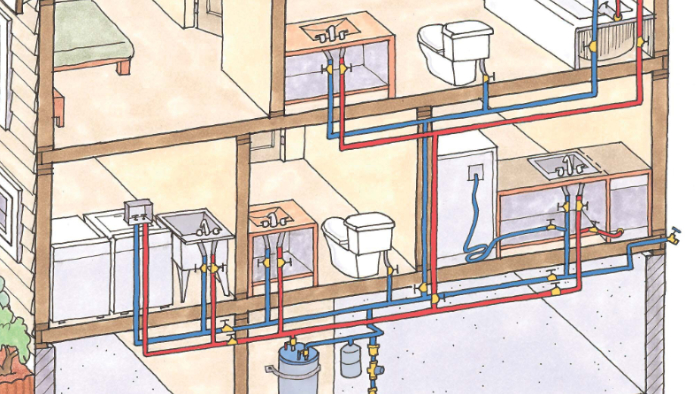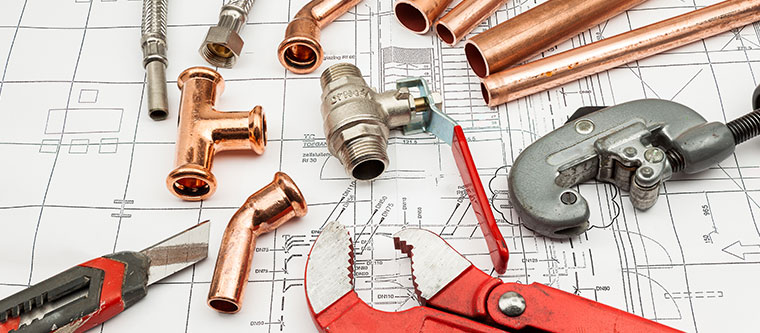Here underneath you'll find lots of exceptional tips concerning Anatomy of a House: Understanding the Components.

Understanding exactly how your home's plumbing system functions is essential for every house owner. From delivering tidy water for drinking, food preparation, and bathing to securely removing wastewater, a properly maintained plumbing system is vital for your family members's health and wellness and comfort. In this detailed guide, we'll check out the intricate network that comprises your home's pipes and deal ideas on upkeep, upgrades, and managing usual problems.
Intro
Your home's plumbing system is greater than just a network of pipelines; it's a complicated system that ensures you have access to clean water and effective wastewater elimination. Recognizing its components and exactly how they work together can help you protect against pricey fixings and make certain whatever runs smoothly.
Standard Elements of a Pipes System
Pipelines and Tubing
At the heart of your plumbing system are the pipelines and tubing that carry water throughout your home. These can be made of various products such as copper, PVC, or PEX, each with its advantages in terms of longevity and cost-effectiveness.
Fixtures: Sinks, Toilets, Showers, and so on.
Fixtures like sinks, commodes, showers, and tubs are where water is utilized in your home. Understanding just how these components connect to the pipes system helps in detecting troubles and preparing upgrades.
Shutoffs and Shut-off Points
Shutoffs control the flow of water in your pipes system. Shut-off valves are crucial throughout emergencies or when you require to make repair services, enabling you to isolate parts of the system without disrupting water circulation to the entire house.
Water System
Key Water Line
The main water line attaches your home to the municipal water or an exclusive well. It's where water enters your home and is distributed to different fixtures.
Water Meter and Pressure Regulatory Authority
The water meter procedures your water usage, while a pressure regulatory authority guarantees that water moves at a risk-free stress throughout your home's plumbing system, stopping damages to pipes and fixtures.
Cold Water vs. Hot Water Lines
Comprehending the difference in between cold water lines, which supply water directly from the main, and hot water lines, which lug heated water from the water heater, assists in repairing and planning for upgrades.
Drainage System
Drain Pipes Piping and Traps
Drain pipes bring wastewater far from sinks, showers, and toilets to the drain or sewage-disposal tank. Catches prevent drain gases from entering your home and likewise catch particles that could trigger clogs.
Ventilation Pipelines
Ventilation pipelines allow air into the drainage system, stopping suction that can slow drain and create traps to empty. Correct ventilation is crucial for maintaining the stability of your pipes system.
Importance of Correct Drainage
Making sure appropriate water drainage avoids backups and water damages. Routinely cleaning up drains pipes and maintaining catches can protect against pricey repairs and extend the life of your plumbing system.
Water Furnace
Types of Water Heaters
Hot water heater can be tankless or standard tank-style. Tankless heaters warmth water as needed, while tanks keep heated water for immediate usage.
Updating Your Plumbing System
Factors for Updating
Upgrading to water-efficient components or changing old pipes can improve water top quality, reduce water expenses, and increase the value of your home.
Modern Pipes Technologies and Their Benefits
Explore innovations like clever leak detectors, water-saving bathrooms, and energy-efficient hot water heater that can save cash and lower environmental impact.
Cost Factors To Consider and ROI
Determine the ahead of time costs versus long-term cost savings when considering pipes upgrades. Many upgrades pay for themselves via lowered utility bills and less repairs.
Just How Water Heaters Connect to the Pipes System
Understanding how hot water heater connect to both the cold water supply and hot water distribution lines assists in detecting issues like insufficient warm water or leaks.
Upkeep Tips for Water Heaters
Consistently flushing your water heater to eliminate sediment, inspecting the temperature level setups, and checking for leaks can prolong its life expectancy and boost power performance.
Common Plumbing Concerns
Leakages and Their Reasons
Leakages can happen because of maturing pipelines, loosened installations, or high water pressure. Attending to leakages immediately stops water damage and mold growth.
Clogs and Clogs
Clogs in drains and toilets are usually triggered by purging non-flushable items or a buildup of grease and hair. Using drainpipe displays and being mindful of what goes down your drains pipes can protect against blockages.
Indications of Plumbing Issues to Look For
Low water stress, slow drains, foul odors, or unusually high water costs are indicators of possible pipes issues that must be addressed without delay.
Plumbing Maintenance Tips
Normal Evaluations and Checks
Set up yearly pipes evaluations to catch concerns early. Search for signs of leaks, deterioration, or mineral accumulation in faucets and showerheads.
Do It Yourself Upkeep Tasks
Easy jobs like cleansing faucet aerators, looking for toilet leakages utilizing color tablet computers, or insulating subjected pipelines in cold environments can avoid major pipes problems.
When to Call a Professional Plumbing Technician
Know when a pipes problem requires specialist knowledge. Trying intricate repair services without appropriate knowledge can lead to even more damage and greater repair service costs.
Tips for Minimizing Water Usage
Straightforward behaviors like fixing leaks without delay, taking shorter showers, and running complete lots of laundry and dishes can preserve water and lower your energy bills.
Eco-Friendly Plumbing Options
Consider sustainable pipes products like bamboo for flooring, which is durable and green, or recycled glass for counter tops.
Emergency situation Preparedness
Steps to Take Throughout a Plumbing Emergency situation
Know where your shut-off valves lie and how to shut off the water supply in case of a burst pipe or significant leak.
Value of Having Emergency Situation Contacts Helpful
Keep contact details for local plumbing professionals or emergency solutions readily offered for quick action during a pipes situation.
Ecological Impact and Conservation
Water-Saving Fixtures and Appliances
Setting up low-flow taps, showerheads, and bathrooms can significantly reduce water usage without compromising performance.
DIY Emergency Fixes (When Suitable).
Momentary solutions like utilizing air duct tape to spot a dripping pipe or placing a container under a leaking tap can lessen damages until an expert plumbing arrives.
Conclusion.
Understanding the composition of your home's plumbing system empowers you to maintain it successfully, saving time and money on repair work. By following regular maintenance routines and staying informed concerning modern-day plumbing innovations, you can ensure your plumbing system runs successfully for several years ahead.
The Anatomy of Your Home s Plumbing System
Understanding the anatomy of your home s plumbing system is essential for any homeowner. It not only helps in identifying potential issues but also facilitates effective communication with professionals when repairs or upgrades are needed. Your home s plumbing system is more than just pipes and faucets; it s a complex network that ensures the efficient and hygienic flow of water in and out of your house. In this blog, we ll dissect the crucial components of your home s plumbing system. For those in Antelope Valley, Brock Plumbing is your trusted partner for all your plumbing needs, ensuring your system functions smoothly and efficiently.
Water Supply System
Main Water Line: This is where your home s plumbing system begins. The main water line connects your home to the public water supply or a private well. Pipes and Shut-off Valves: Pipes distribute water throughout your home. Shut-off valves are crucial for controlling the flow of water and making repairs without shutting off the entire system. Drainage System
Drain Pipes: These pipes carry waste and water away from sinks, toilets, and showers. Vents: Vents allow sewer gases to escape and help maintain proper pressure in the drainage pipes, ensuring efficient flow of wastewater. Traps: Every fixture has a trap, a U-shaped pipe that holds water and prevents sewer gases from entering your home. The most common is the P-trap under sinks. Fixtures and Appliances
Fixtures and appliances are the most interacted with parts of your plumbing system. They include sinks, toilets, showers, dishwashers, and washing machines. Each fixture and appliance has its own supply and drainage connection, ensuring they receive clean water and can dispose of wastewater effectively.
Water Heating System
Your water heater is a crucial component, providing hot water to various fixtures and appliances in your home. It can be tank-based or tankless, with each type having its own set of advantages and maintenance requirements. Regular maintenance is essential to ensure efficient operation and extend the lifespan of the unit.
Sump Pump
In areas prone to flooding or with high water tables, a sump pump is an essential part of the plumbing system. It s installed in the lowest part of your basement or crawlspace and pumps out water that accumulates, preventing flooding and protecting your home from water damage.
Septic System
Homes that are not connected to a municipal sewer system have a septic system and an underground wastewater treatment structure. Understanding how to maintain your septic system is crucial to prevent backups, odors, and early system failure.
Conclusion
Your home s plumbing system is a complex and essential network, ensuring the efficient and hygienic flow of water in and out of your property. Understanding its key components helps in maintaining it properly and identifying issues before they escalate into major problems. For residents in Antelope Valley, Brock Plumbing is dedicated to providing top-notch services, ensuring that every part of your plumbing system is in perfect working order. Trust our team of professionals to handle all your plumbing needs, ensuring your home remains comfortable, safe, and well-maintained.
https://brockplumbinganddrains.com/blog/the-anatomy-of-your-homes-plumbing-system/

I am very drawn to Plumbing Installation 101: All You Need to Know and I am hoping you enjoyed reading my article. If you liked our blog post plz consider to pass it around. We value reading our article about The Inner Workings of Your Home's Plumbing.
Schedule Service Now